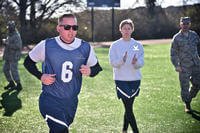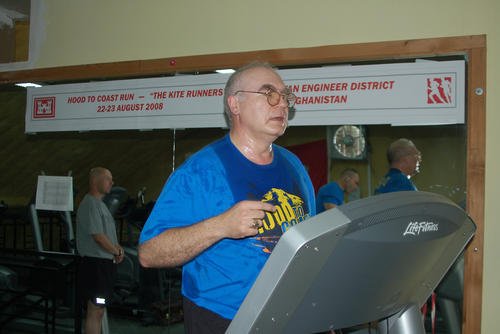When it comes to physical training, there are some basic rules if you want to see long-term results with minimal risk of injury with calisthenics and events required for military fitness tests.
Here is an email about the skills many people strive to acquire when they begin to exercise: strength, muscle growth and performance.
Hey Stew, I am focused on calisthenics improvement for some future fitness tests: pull-ups, push-ups, sit-ups, plank and leg tucks. I am kind of skinny but a good runner. I am curious. Can you build muscle with calisthenics? How about daily calisthenics? Would these help me gain weight and improve on strength? Thanks, Greg.
Can You Gain Muscle with Calisthenics? Yes
Greg, to answer your first question, absolutely. Many younger teens I work with start with a foundation of calisthenics before I move into weighted versions of many of the same movements. Sure, when calisthenics start to get easier, you can add a weight vest or dumbbells to make calisthenics tougher. However, starting off with classic calisthenics and no added weight is one of my favorite methods to build initial strength, gain muscle mass and increase performance for military-style fitness tests.
For most people who are just starting out and need to increase muscle mass and strength, getting to the point where calisthenics are easy will take more than a few weeks. It can take several months before you see enough progress in this area to consider adding weights.
Be patient with the training and get on a system that varies your workouts. Daily repetitions of the same exercises are not a good long-term plan, especially as you increase the volume of sets and repetitions each week.
Here are some of the rules you need to consider in this journey:
1. Recovery
Your body needs to recover from resistance training. Calisthenics is a form of resistance training and is very similar to weight training. In some exercises, they’re even harder than weight training.
Pull-ups and dips are the “heavyweight training” of the calisthenics world, as you are lifting (pulling or pushing) your entire body weight when you do these with your arms. Squats and lunges are similar, but the legs, by nature, can handle your body weight easier than your arms can.
You still need recovery days for your legs, especially after high-volume calisthenics workouts. Building muscle with calisthenics is part of the process. It will happen as long as you spend time eating well, sleeping well and giving your body a day to recover between upper-body days.
2. Split Routine vs. Daily Calisthenics
There is nothing wrong with daily calisthenics, especially if you wake up and do a few push-ups each day. If you are going to exercise daily with high volume or do back-to-back days, you should consider doing an upper-body day that includes push-ups, sit-ups, pull-ups, dips, plank pose and other variations one day.
The next day after that upper-body workout is a good day to work the legs and build some strength and muscle stamina with a combination of running intervals, squats, lunges, jumps and other leg exercises.
Your training volume will increase as you continue to train. Volume is relative. What one person considers high volume may be another’s set of warmup reps.
When you start to get into the volume of 100 pull-ups and 200+ push-ups, you absolutely need a day or two to recover from that volume before you repeat. See Classic Military PT Week of Training article for ideas on upper- and lower-body split routines.
3. Performance Gains
The first pull-up you perform is a strength exercise. Your 10th to 20th pull-up is now an endurance exercise. Gaining strength is a process of building muscle through exercise and proper recovery.
You only grow when you recover and sleep. As mentioned in the recovery paragraph above, you need to pursue methods of recovery actively to gain the results you seek. There is a fine line with training where too much recovery (not training enough) and not enough recovery (too much training) meet to create the sweet spot where growth and performance increase.
At some point, increasing the volume of daily calisthenics will become detrimental to your recovery, and you will see a plateau, negative results or injury if high-volume daily activity is prolonged.
To build muscle stamina and achieve higher numbers on a fitness test, you need a combination of high-volume training and recovery. Split routines offer that ability to do both.
Finally, if you want to gain weight, you also must eat big. Add additional calories from all food sources (fats, protein, carbs). You need calorie-dense foods that are also healthy for you.
You may find eating anything you want tough to do. Add peanut butter and jelly sandwiches or milkshakes after meals for additional calories, especially if you are considered a “hard gainer.” My 6-foot-3, 140-pound son started with calisthenics in ninth grade, evolved into dumbbells, then weight training using the following split routine:
Monday: upper body
Tuesday: lower body
Wednesday: rest day or sports day
Thursday: upper body
Friday: lower body
Saturday and Sunday: sports weekend or rest
This is just one of many ways to create your split routine.
My hard-gaining son used this cycle all through high school and continued to grow into a 6-3, 195-pound senior. He did this with just real food and daily instant breakfast drinks in the morning and before bed.
Stew Smith is a former Navy SEAL and fitness author certified as a Strength and Conditioning Specialist (CSCS) with the National Strength and Conditioning Association. Visit his Fitness eBook store if you’re looking to start a workout program to create a healthy lifestyle. Send your fitness questions to stew@stewsmith.com.
Want to Learn More About Military Life?
Whether you're thinking of joining the military, looking for fitness and basic training tips, or keeping up with military life and benefits, Military.com has you covered. Subscribe to Military.com to have military news, updates and resources delivered directly to your inbox.


















